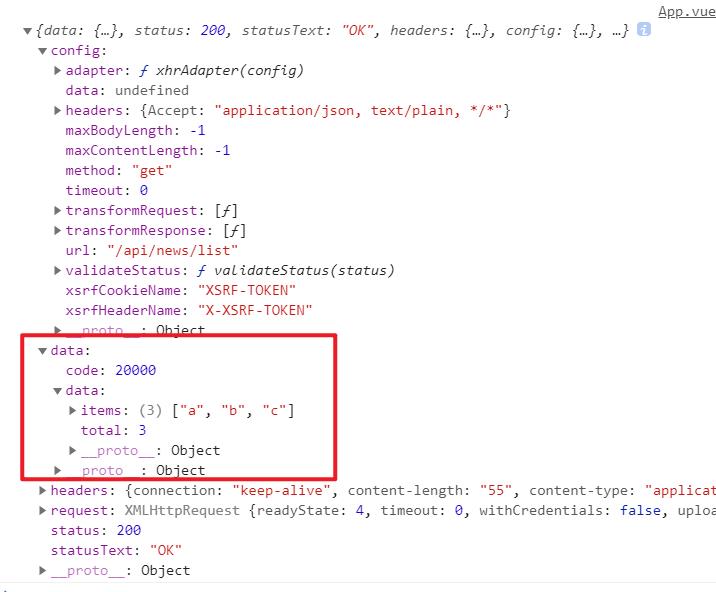vue中使用mock数据
Posted 奥特曼
tags:
篇首语:本文由小常识网(cha138.com)小编为大家整理,主要介绍了vue中使用mock数据相关的知识,希望对你有一定的参考价值。
mock使用场景:后端接口的开发速度跟不上前端的进度, 而前端要实现业务还必须依赖数据,前端为了保证开发进度就需要自己去创建mock数据 ,才能保证业务正常开发。
mock的数据是我们自己定义的假数据,常称为mock数据
实现方式
线上mock https://www.fastmock.site/
手动写
使用步骤
1. 下载包
npm i axios mockjs 2.引如mock文件
mock/mock-server.js
const chokidar = require('chokidar')
const bodyParser = require('body-parser')
const chalk = require('chalk')
const path = require('path')
const Mock = require('mockjs')
const mockDir = path.join(process.cwd(), 'mock')
function registerRoutes(app) {
let mockLastIndex
const { mocks } = require('./index.js')
const mocksForServer = mocks.map(route => {
return responseFake(route.url, route.type, route.response)
})
for (const mock of mocksForServer) {
app[mock.type](mock.url, mock.response)
mockLastIndex = app._router.stack.length
}
const mockRoutesLength = Object.keys(mocksForServer).length
return {
mockRoutesLength: mockRoutesLength,
mockStartIndex: mockLastIndex - mockRoutesLength
}
}
function unregisterRoutes() {
Object.keys(require.cache).forEach(i => {
if (i.includes(mockDir)) {
delete require.cache[require.resolve(i)]
}
})
}
// for mock server
const responseFake = (url, type, respond) => {
return {
// url: new RegExp(`${process.env.VUE_APP_BASE_API}${url}`),
url: new RegExp(`${url}`),
type: type || 'get',
response(req, res) {
console.log('request invoke:' + req.path)
res.json(Mock.mock(respond instanceof Function ? respond(req, res) : respond))
}
}
}
module.exports = app => {
// parse app.body
// https://expressjs.com/en/4x/api.html#req.body
app.use(bodyParser.json())
app.use(bodyParser.urlencoded({
extended: true
}))
const mockRoutes = registerRoutes(app)
var mockRoutesLength = mockRoutes.mockRoutesLength
var mockStartIndex = mockRoutes.mockStartIndex
// watch files, hot reload mock server
chokidar.watch(mockDir, {
ignored: /mock-server/,
ignoreInitial: true
}).on('all', (event, path) => {
if (event === 'change' || event === 'add') {
try {
// remove mock routes stack
app._router.stack.splice(mockStartIndex, mockRoutesLength)
// clear routes cache
unregisterRoutes()
const mockRoutes = registerRoutes(app)
mockRoutesLength = mockRoutes.mockRoutesLength
mockStartIndex = mockRoutes.mockStartIndex
console.log(chalk.magentaBright(`\\n > Mock Server hot reload success! changed ${path}`))
} catch (error) {
console.log(chalk.redBright(error))
}
}
})
}
mock/new.js
module.exports = [
{
url: '/news/list',
type: 'get',
response: config => {
return {
code: 20000,
data: {
total: 3,
items: ['a', 'b', 'c']
}
}
}
}
]mock/index.js
const Mock = require('mockjs')
const { param2Obj } = require('./utils')
const user = require('./user')
const table = require('./table')
const news = require('./new')
const mocks = [
...user,
...table,
...news
]
// for front mock
// please use it cautiously, it will redefine XMLHttpRequest,
// which will cause many of your third-party libraries to be invalidated(like progress event).
function mockXHR() {
// mock patch
// https://github.com/nuysoft/Mock/issues/300
Mock.XHR.prototype.proxy_send = Mock.XHR.prototype.send
Mock.XHR.prototype.send = function() {
if (this.custom.xhr) {
this.custom.xhr.withCredentials = this.withCredentials || false
if (this.responseType) {
this.custom.xhr.responseType = this.responseType
}
}
this.proxy_send(...arguments)
}
function XHR2ExpressReqWrap(respond) {
return function(options) {
let result = null
if (respond instanceof Function) {
const { body, type, url } = options
// https://expressjs.com/en/4x/api.html#req
result = respond({
method: type,
body: JSON.parse(body),
query: param2Obj(url)
})
} else {
result = respond
}
return Mock.mock(result)
}
}
for (const i of mocks) {
Mock.mock(new RegExp(i.url), i.type || 'get', XHR2ExpressReqWrap(i.response))
}
}
module.exports = {
mocks,
mockXHR
}
3.配置vue.config.js
'use strict'
module.exports = {
/**
* You will need to set publicPath if you plan to deploy your site under a sub path,
* for example GitHub Pages. If you plan to deploy your site to https://foo.github.io/bar/,
* then publicPath should be set to "/bar/".
* In most cases please use '/' !!!
* Detail: https://cli.vuejs.org/config/#publicpath
*/
publicPath: './',
outputDir: 'dist',
assetsDir: 'static',
productionSourceMap: false,
devServer: {
port: 8001,
open: true,
overlay: {
warnings: false,
errors: true
},
before: require('./mock/mock-server.js') // 重点
}
}
4. 去页面中使用:
<template>
<div id="app">
<button @click="send"></button>
</div>
</template>
import axios from 'axios'
export default {
name: 'App',
methods: {
send() {
const url = "/api/news/list"
axios({url}).then(res => {console.log(res)})
}
},
}
</script>
以上是关于vue中使用mock数据的主要内容,如果未能解决你的问题,请参考以下文章